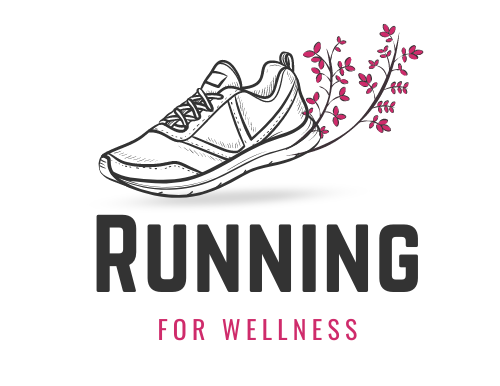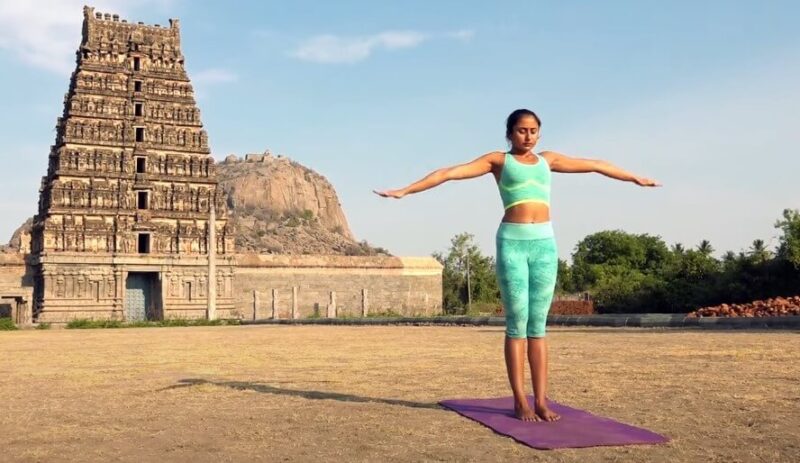When your belly feels tight, crampy, or bloated, even simple tasks can feel like a drag. Whether it’s stress, your cycle, digestive issues, or postpartum recovery, abdominal tension has a way of throwing everything off.
The good news? Yoga can help in more ways than one, and it doesn’t require a hardcore session or perfect form.
Today, we prepared for you a practical, body-aware yoga sequence tailored specifically for women looking to ease abdominal tension.
You’ll find step-by-step instructions, clear benefits, and modifications to fit your energy level and comfort zone. And if you’re dealing with cramps, IBS, or just that nagging tightness that won’t quit, you’ll want to keep this one bookmarked.
A Quick Look
| Pose | Primary Benefits | Duration | Modifications |
| Child’s Pose | Relaxes belly, eases cramps, calms mind | 1–2 minutes | Support forehead with block or pillow |
| Knees-to-Chest | Relieves gas, massages abdomen | 5–10 breaths x3 | Hug one knee at a time |
| Supine Twist | Massages organs, reduces bloating | 30–60 sec/side | Use bolster under knees |
| Seated Forward Bend | Relieves stress, stretches back and belly | 5–10 breaths | Strap around feet, knees bent |
| Downward-Facing Dog | Stimulates digestion, energizes body | 5–10 breaths | Bend knees, use wall support |
| Bridge Pose | Strengthens core, reduces bloating | 5–10 breaths x3 | Block under sacrum |
| Seated Spinal Twist | Improves digestion, eases abdominal tension | 5+ breaths/side | Sit on blanket, keep bottom leg long |
| Savasana | Full-body reset, deep relaxation | 5–10 minutes | Support under knees, eye pillow |
| Camel Pose | Eases menstrual tension | 5 breaths | Hands on lower back or blocks |
| Seated Cat-Cow | Gentle spine and belly movement | 1–2 minutes | Use a chair if needed |
Why Yoga Works for Abdominal Tension
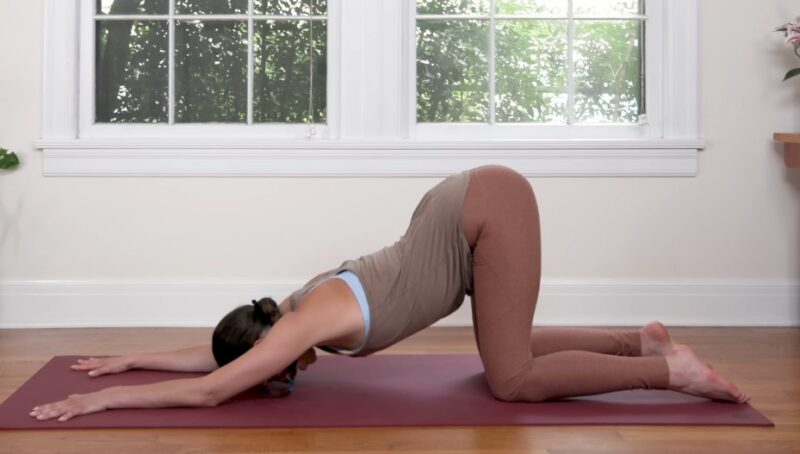
Yoga isn’t just about stretching. It combines physical movement with breathwork and mindfulness to create a full-body reset, especially effective when tension builds in your midsection. Let’s break it down.
What Yoga Can Do
- Relax the Abdominal Muscles: Poses like Child’s Pose and Knees-to-Chest create gentle compression or space, depending on the posture, that encourages the belly to soften.
- Stimulate Digestion: Twists and gentle forward folds help move things along in the gut, which is crucial when bloating or sluggish digestion is part of the picture.
- Ease Stress: Cortisol, the body’s main stress hormone, can mess with digestion and muscle tone. Deep breathing and relaxation poses can help lower those levels and take the pressure off.
- Support Menstrual and Postpartum Recovery: Some yoga positions specifically address uterine cramping or the rebuilding of core strength after childbirth or subserosal fibroid treatment.
- Build a Resilient Core: A stronger core can improve posture and reduce the tendency to hold tension in the abdomen long-term.
The Science Backs It Up
A 2021 study in Gastroenterology and Hepatology found that short-term physical activity, including yoga, eased gastrointestinal symptoms in people with functional bloating.
Deep breathing has also been shown to reduce cortisol levels, which helps with stress-related tension.
And if you’ve ever tried a gentle twist after a heavy meal, you already know how effective it can feel in the moment.
Yoga Sequence to Ease Abdominal Tension
This sequence is designed to be gentle but effective. It starts slow, builds gently, and ends in full-body relaxation. Practice in the order listed, and feel free to add props or take breaks when needed.
1. Child’s Pose (Balasana)
Kneel with your big toes touching and knees hip-width apart. Sit your hips back on your heels, fold forward, and stretch your arms out in front of you. Let your forehead rest on the mat or a pillow.
Why it helps
Relaxes belly tension and eases cramps. Also quiets the nervous system, a major win if you’re holding stress in your gut.
Duration
1–2 minutes, slow nasal breathing.
Modifications
Use a bolster under the torso or a pillow under the forehead. If kneeling is tough, sit on a folded blanket.
2. Knees-to-Chest Pose (Apanasana)
Lie on your back and hug both knees to your chest. You can rock side to side gently.
Why it helps
Creates mild pressure on the abdomen that encourages digestion and eases gas pain.
Duration
5–10 breaths. Repeat up to three times.
Modifications
Bring in one knee at a time if that feels better. You can also use a strap behind the knees if your arms get tired.
3. Supine Twist
Lying on your back, bring knees up toward your chest. Drop both knees to one side while turning your head to the other. Arms outstretched like a “T.”
Why it helps
Massages internal organs and stretches the belly. Great for reducing cramping or bloating.
Duration
30–60 seconds per side.
Modifications
Rest knees on a pillow or bolster. Keep the knees higher toward the chest for a gentler version.
4. Seated Forward Bend (Paschimottanasana)
Sit with legs extended. Inhale to lengthen spine, then exhale and fold forward from the hips.
Why it helps
Promotes relaxation while lengthening the spine and gently compressing the belly.
Duration
5–10 breaths.
Modifications
Use a strap around the feet. Slightly bend your knees if needed to avoid lower back strain.
5. Downward-Facing Dog (Adho Mukha Svanasana)
From hands and knees, tuck your toes and lift hips high to form an inverted V.
Why it helps
Improves circulation and stimulates digestion. Stretches the whole body and gently lifts pressure off the abdomen.
Duration
5–10 breaths.
Modifications
Bend knees or use a wall for support. Focus more on the length in your spine than on straight legs.
6. Bridge Pose (Setu Bandha Sarvangasana)
Lie on your back, knees bent, feet hip-width apart. Press feet into the floor to lift your hips. Hands can clasp underneath or stay at your sides.
Why it helps
Strengthens lower back and core while stimulating digestive organs.
Duration
5–10 breaths, repeat 2–3 times.
Modifications
Use a block under your sacrum for a supported version. Adjust foot placement to control intensity.
7. One-Legged Seated Spinal Twist
Sit with both legs extended. Cross right leg over left thigh. Inhale to sit tall, exhale and twist to the right.
Why it helps
Twists like this one aid digestion and relieve tension in the belly and back.
Duration
5–8 breaths each side.
Modifications
Keep bottom leg straight if bending it is uncomfortable. Sit on a blanket for better alignment.
8. Resting Corpse Pose (Savasana)
Lie on your back, arms relaxed at your sides, palms up. Legs slightly apart. Close your eyes and breathe naturally.
Why it helps
Releases residual tension, helps integrate the benefits of the practice, and encourages deep rest.
Duration
5–10 minutes.
Modifications
Use a pillow under your knees or an eye pillow over your eyes.
Bonus Poses for Specific Needs
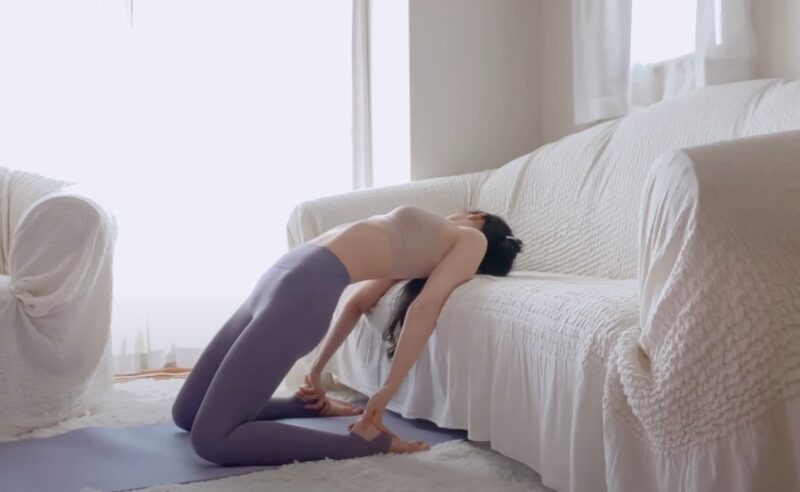
Sometimes abdominal tension comes with a specific backstory: cramps, pregnancy recovery, or nausea. These extra poses can help.
Camel Pose (Ustrasana)
Why try it?
Stretches the belly and signals the uterus to relax. Especially useful during menstruation.
Mod it
Place hands on lower back if reaching for the heels is too much.
Seated Cat-Cow (Chair or Floor)
Mobilizes the spine gently and encourages the belly to release without lying down.
Mod it
Do this on a chair if sitting on the floor is uncomfortable.
Add Breathwork for More Relief
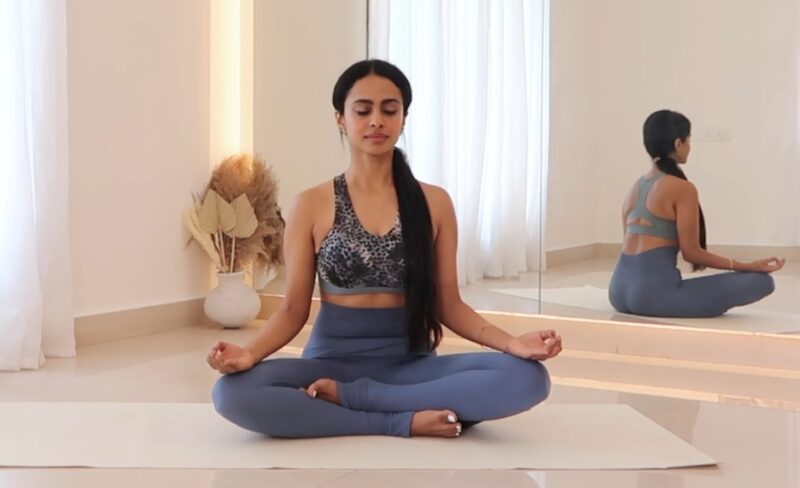
Pranayama (Deep Belly Breathing)
Sit comfortably. Breathe in through the nose, letting your belly expand. Exhale slowly, feeling your belly soften.
Why it helps
Activates the parasympathetic nervous system, helping the body shift out of stress mode.
Duration
5–10 breaths or up to 5 minutes.
Tips for Safe Practice
- Drink Water: Hydration helps ease cramping and aids digestion. A few sips before and after practice can go a long way.
- Eat Light: Skip heavy meals before yoga. A small snack like fruit or yogurt is fine if needed.
- Be Consistent: A few sessions a week make a bigger difference than one long class. Aim for 3–4 times weekly.
- Use Props: Blankets, blocks, pillows, whatever supports you is fair game.
- Modify Freely: There’s no gold star for pushing through pain. Do what works for your body today.
- Talk to a Pro: If you’re dealing with IBS, endometriosis, or are postpartum, check in with a yoga therapist or your healthcare provider to tailor the practice.
Final Thoughts
Abdominal tension doesn’t have to be your default setting. With a few thoughtful yoga poses, some conscious breathing, and a regular rhythm, you can start to feel more comfortable in your core and your life.
Whether it’s cramps, bloating, stress, or recovery, this flow offers gentle support exactly where it’s needed. No pressure, no perfection, just real relief. Keep moving, keep breathing, and let your belly soften.
Related Posts:
- Top 400 Hilarious Gym Quotes to Keep You Motivated
- How Long Does It Take to Train for a Half Marathon?
- 25 Simple Running Motivation Tips To Get You Moving
- Half Marathon Training Plan for Beginners - Simple…
- How Far Is a Half Marathon? Everything You Need to Know
- How Can You Start a Career as a Running Coach?
